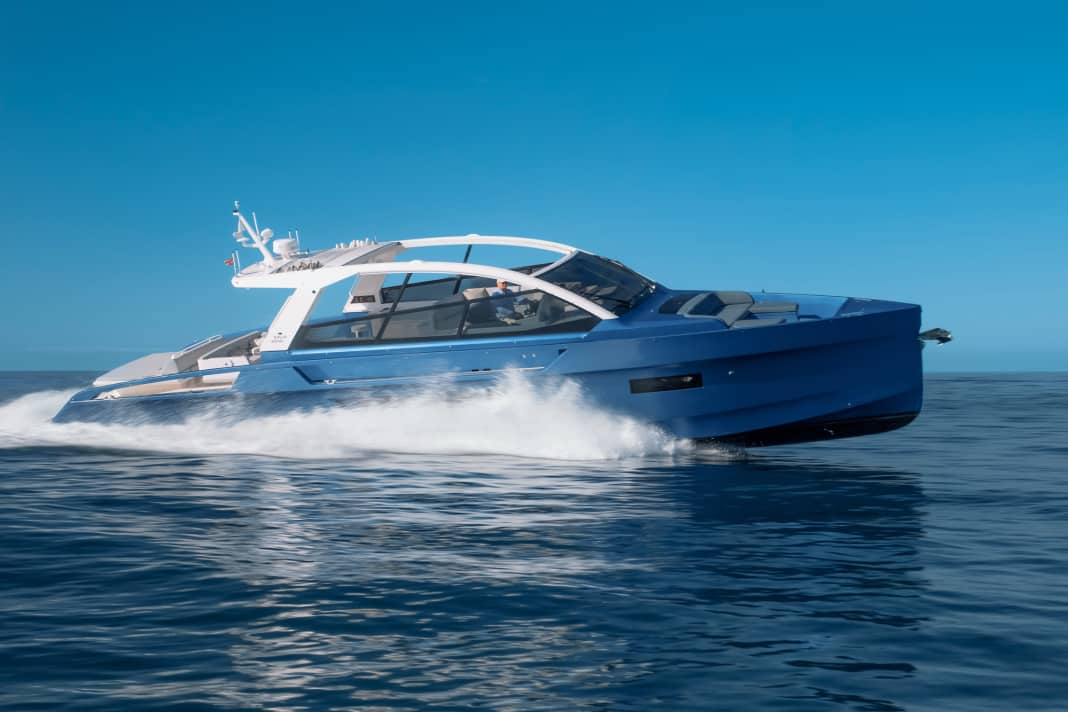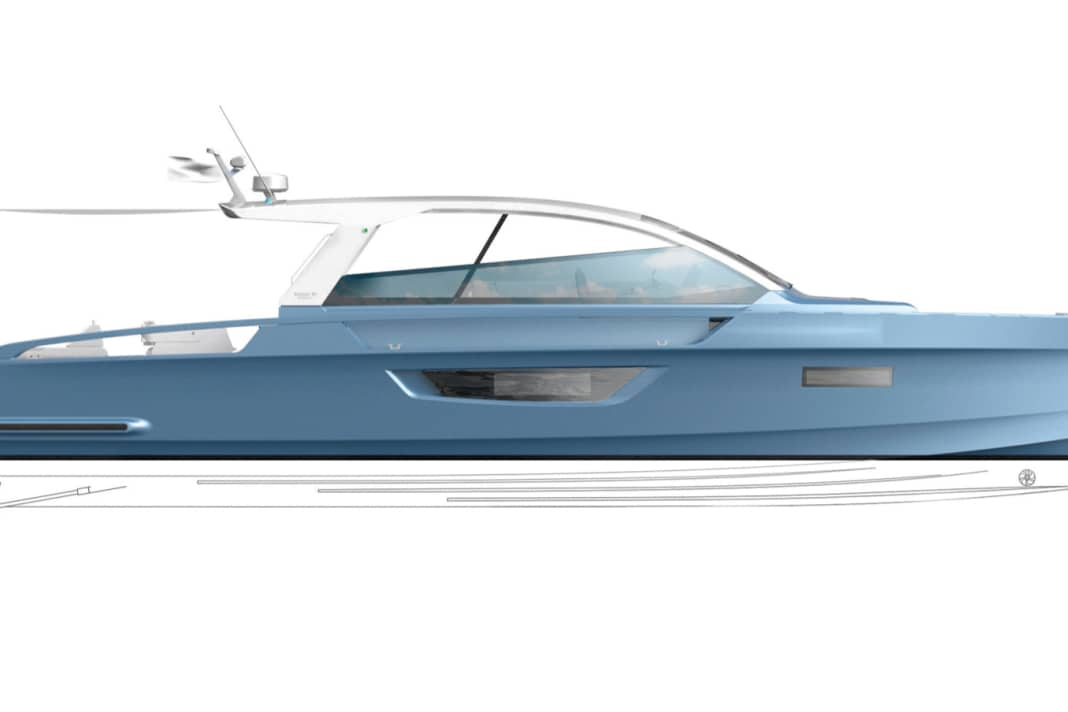"Sialia": Fully electric weekender with specially developed XXL battery banks
Sören Gehlhaus
· 02.01.2024






The diesel has been humming on the port side for ten minutes, while odours and exhaust fumes permeate the morning air on the starboard side. The Sialia 57 is surrounded by combustion engines at the Cannes Yachting Festival and is not moored with the smaller powerboats a few jetties away. An advantage? Definitely, the confrontation results in an absolutely unique position. You will look in vain for banners advertising the emission-free drive system. A deliberate decision, explains Sales and Marketing Manager Ivo Hagemans. The aim was to draw attention to the sailing yacht-like lines of Dutch designer Denis Popov and the paintwork. Finally, three windows in the EcoDeck on board provide information about the lithium-ion batteries and two electric motors. The almost 18-metre-long "Deep Silence" aims to demonstrate that the attributes of all-electric and fast are not mutually exclusive for monohulls in weekender format. And the range? "That's the question we're asked first in the vast majority of conversations," says Hagemans.
Non-stop journeys up to 280 nautical miles possible with Sialia
Strictly speaking, Sialia's debut model is not a purely electric vehicle, it is a full hybrid thanks to the "range extender", the name given to the 390-kilowatt generator, which is not mandatory under 24 metres. "It runs at variable speeds and supplies direct current like a fast charging station," explains founder and CEO Tomasz Gackoski. The batteries can be charged in 45 minutes while travelling. With the generator, non-stop journeys of up to 280 nautical miles are possible; range anxiety should not materialise. With a fully charged 256-kilowatt-hour battery bank, the boat can travel 28 nautical miles at eight knots and eleven nautical miles at 16 knots. At 25 knots, the radius of action is eight nautical miles. "That's more than enough for many people," says Ivo Hagemans. "We have liaised with brokers on Mallorca and received movement profiles from day charterers."
When casting off, the bow thruster seems to roar loudly, but in reality it is not drowned out by the noise emissions of the main engine. The electric motors, each with 400 kilowatts of continuous power and 500 kilowatts of maximum power, run in limited mode when manoeuvring and do not release their torque at the slightest touch of the command transmitter. After Cannes' Vieux Port lies astern, the captain makes way and positions himself within reach. Even in normal mode, you have to hold on to one of the many handrails. The Sialia, which only displaces 19 tonnes, glides quickly and without lifting the bow, the stern sea is flat and the full circle is achieved in a two-boat-length diameter. The higher the revs, the less jerky the acceleration. At 26 knots, the heavily skimmed hull swallows the small waves and nothing rattles on the convertible hardtop. To get the high torque into the water, two large Veem propellers turn on wave systems and in tunnels.
Under full load, the e-units together demand 800 kilowatts from the electrochemical energy storage system. What about battery safety? "The power shuts down automatically as soon as the cables get too hot or there is insufficient ventilation," says Tomasz Gackoski, who also provides the drivetrain with Ampros. Hagermans adds: "Before a thermal runaway occurs, six safety devices have taken effect, each of which ensures that the system is shut down." In addition to the fire extinguishing system, redundancies - there are always two voltage transformers, for example - are designed to prevent a fire. The three battery banks also operate independently of each other: if one string fails, the others continue to supply power.
Sialia runs on Ampros batteries
Gackoski is also working with Ampros on solutions that put the "energy room" under water. "We have carried out a risk analysis. As we are not far from the coast with this boat, we have refrained from doing this." However, implementation would be possible, also in view of the changed load distribution. Ampros is equipping an 80-foot aluminium yacht that will be sailing around the world with individually floodable battery banks. For the commercial sector, a jettison system is being developed in which a flap opens in the underwater hull, similar to a moon pool, and the batteries fall out of the hull. It shouldn't come to that. "We know exactly what's in our batteries, I designed them with Stan, my partner at Ampros and Sialia." Gackoski is talking about Stanislav Szadkowski. The Polish businessman founded ICPT (now Impact), a Warsaw-based battery manufacturer specialising in heavy-duty land-based applications. The Ampros batteries are tailored to the acceleration requirements of maritime use and consist of "carefully tested components", says Gackoski.
On the Sialia 57, all data is collated in the Ship Management System (SMS), which in theory should also protect against improper use, for example due to overloading. Even the water temperature is included in the automated analysis. In Cannes, many shipyards enquired about Ampros drives, even if expectations for uncomplicated retrofitting had to be dampened. The hull had to be tailored to the electric motorisation. Sialia relies on the calculations of the Dutch design office Vripack.
"Increasing performance is quite easy with diesels. For us, more power always means more batteries and therefore more weight," emphasises engineer Gackoski, who carried out structural calculations for fast carbon sailboats at Structeam on the Isle of Wight, including Wally. Co-founder Szadkowski's "Deep Silence" came from Latitude Yachts in Riga, Latvia, with a simple, solid interior that still showed room for improvement towards the superyacht standard. Based on the extended hull shape of the 57, the Sialia 59 is entering the market with carbon fibre production by Rega Yachts in Poland. An aluminium version is also on offer, which is said to weigh only 200 kilograms more by lowering the freeboard.
The challenge lies in pricing
In Cannes, the trip ends after a good hour. The reason: due to the many customers in the harbour, only ten kilowatts of shore power flowed into the NMC batteries. So far, fast charging has only been tested with 150 kilowatts because the infrastructure of the Mediterranean harbours does not allow for more. "Theoretically, the batteries could handle 500 kilowatts, but the CCS plug only allows a maximum of 350 kilowatts," says a disillusioned Gackoski. He plans to equip the 59 with fuel cells or a battery storage system with a capacity of one megawatt hour. With the additional five tonnes of batteries, the design waterline would even be maintained, as the elimination of the generator and 1500-litre tank would save 4.5 tonnes. A bold and consistent endeavour for a boat of this length. At 4.5 megawatt hours, the recently delivered superyacht has the largest battery capacity of any superyacht. 84-metre "Obsidian" Feadship . Ampros is realising a solution with a capacity of seven megawatt hours for a ferry. The challenge is not the scalability of the batteries. Rather in the pricing. The fully equipped Sialia 57 is already estimated to cost 4.6 million euros.
Technical data





- Length over everything: 17,60 m
- Width: 4,70 m
- Depth: 0,95 m
- Displacement (empty):19 t
- Material: Carbon
- Length over everything:17.60 ms
- Engine power:2 x 400 kW
- Engine power: 2 x 400 kW 26 kn
- Speed (travelling): 16 kn
- Range (hybrid): 280 nm
- Range (hybrid): 280 nm @ 8 kn): 28 nm
- Batteries: Ampros, 256 kWh
- Diesel generator: 390 kW
- Diesel generator: 390 kW
- Navigation: Garmin
- Construction: Vripack
- Exterior design: Denis Popov Design
- Interior design: Denis Popov Design
- Shipyard:Sialia Yachts, 2022

